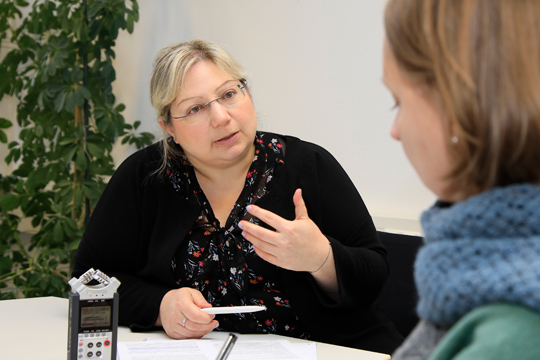Open to Open-Plan
Freiburg, Mar 02, 2020
These days when offices are being set up or redeveloped, 88 per cent of them tend to be open-plan. On the one hand these open spaces with areas for different tasks can be seen as a rationalizing tool. On the other, they meet the needs of working in the digital age and the increased pace. A narrow majority of employees is satisfied with their open-plan workplace, but there are also challenges. Annette Hoffmann talked with Cathrin Becker from the Chair of Business Psychology at the University of Freiburg about this.

Chat at the counter and the table: the Freiburg Center for Systems Biology offers staff open-plan areas that they can use for meetings and so on. Photo: Ingeborg F. Lehmann
Ms Becker, you’ve been working on the PräGeWelt study into the design of new open-plan work environments for three years. What does your office look like?
Cathrin Becker: Anything but open-plan. It’s a fairly large and light individual office. Sometimes I also work from home as well. Again, that’s typical of open-plan working. For tasks with specific requirements you can find suitable spaces. That can also mean a home office.
Have you changed your workspace at all during the project?
Yes, I’ve organized my workspace at home to be more comfortable. Some examples have shown that the furniture makes a lot of difference. I’ve bought a better chair and sometimes I also sit on a ball now. Some of my colleagues have also arranged their university offices more comfortably and created a cozy corner with rugs and seating.
Does the name “PräGeWelt” imply the idea that the work environment shapes our lives?
Our project, where we followed eight businesses scientifically, was less about impact than prevention in the design of new open-plan work environments. So we studied what preventive steps you can take to ensure work goes well. We focused on health, especially mental health.
So, work makes you sick?
It doesn’t have to, but it can. There are reasons why there have been many issues because of mental illness in recent years. Prevention is very important here.

Even if open-plan workstations are popular, it’s still important to feel you belong in the office, says Cathrin Becker: “As soon as staff have a permanent desk they set up their plant and their picture.” Photo: Ingeborg F. Lehmann
What do open-plan offices say about our work environment?
They indicate a change in the work environment. Unlike the huge offices of the 1980s, open-plan workspaces involve the reorganization of processes. When I have to focus on my work, I can choose the home office or go into a meeting room or quiet room. You use the available possibilities. Of course this all arose because work has become more flexible and faster. Open-plan is an answer to everything having to be dynamic and there being more interaction. But now you don’t just meet colleagues to work in the cafeteria, things have changed as regards company management as well.
Doesn’t it obscure hierarchies when management also work in open-plan offices?
There are differences here too. Many concepts are still designed for the individual office. When management sit with their colleagues, it also gives rise to new challenges – not a loss of power, but management become more approachable. Many employees see it as positive that they don’t have to go specially to the office of their superior to make an appointment. Some management also say they notice conflicts before they escalate, and can resolve them sooner. But being constantly accessible is also more stressful for management. You have to learn to be open-plan.
Do people generally feel happy with open-plan?
In the analyses there was a general tendency to be satisfied. When we asked about this in qualitative interviews, everyone saw some positives and some negatives. Someone who is delighted with a height-adjustable table can be dissatisfied at the same time because the office is noisy. Whether it suits is also a question of personality type – far more than an age or gender issue. Another thing that’s important is whether you change from an individual or an old-style open-plan to a new-style open-plan workspace.
When everything’s so individual doesn’t it become difficult to make improvements?
Some improvements are always and generally possible, such as acoustics. Some businesses were able to improve this with acoustic panels. In other companies we found that staff were bothered by their colleagues walking around behind them. So they marked out permanent paths. Many staff use headphones to reduce the noise. There are things that companies can do for themselves, other problems have to be solved by everyone individually. It’s still a dynamic process.
Don’t we need a little private stuff, such as an office mug or family photos, to identify with the workplace?
As soon as staff have a permanent desk they set up their plant and their picture. Even in companies with a “clean desk policy” staff are provided with lockers to lock up their personal things overnight. As far as private conversations go, they’re not so common in open-plan offices or they may move to other areas such as the cafeteria. All the same, it’s important to feel you belong in the office. And the office will remain important, even if there is the home office and many contacts with customers. It’s a port of call for everyone. You could also say “Hub and Home”.

